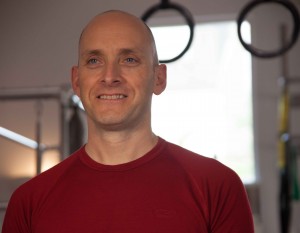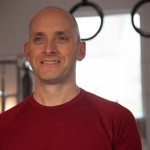 Mike Perry – Mike’s introduction to Pilates came as a result of a lower back injury, partly caused by a passion for running but without proper muscular balance or physical awareness. Needing to cut back on running, he turned to cycling and triathlon instead but still suffered recurring bouts of severe back pain. On the recommendation of an osteopath he began Pilates studio classes and within a few sessions had decided to apply to train to be a Pilates teacher.
Mike Perry – Mike’s introduction to Pilates came as a result of a lower back injury, partly caused by a passion for running but without proper muscular balance or physical awareness. Needing to cut back on running, he turned to cycling and triathlon instead but still suffered recurring bouts of severe back pain. On the recommendation of an osteopath he began Pilates studio classes and within a few sessions had decided to apply to train to be a Pilates teacher.
Given that, at the time, dance was the usual background for teachers, Mike felt very fortunate that a carpenter and cabinet maker could train to teach Pilates. He qualified as a Pilates matwork teacher in 2003 and completed his training in 2004.
More recently, Mike has been researching an evolutionary biology perspective on human health and movement, as championed by the likes of Mark Sisson, Katy Bowman and many others. This means a keen interest in nutrition, strength & conditioning and (much like Joseph Pilates) how our whole lifestyle influences our health. This is in keeping with the Pilates in Motion Studio philosophy that Pilates is a beginning, rather than an end in itself, and that, along with the many other benefits of Pilates, increased strength is an outcome we hope all of our clients will seek.
He is also a CrossFit Level 1 Trainer, and CrossFit Mobility Trainer.
Mike makes occasional blog posts, covering Pilates, fitness and nutrition, that can be seen at www.paleolates.com.

I wonder if anyone would argue that there is a better way to train to be a Pilates teacher than to serve an apprenticeship under an experienced teacher within a Pilates studio. I imagine that modular training courses exist not because they have the best outcomes, but rather because they make economic sense. I’m sure that many people who are interested in becoming Pilates teachers are not able to commit the necessary time, money, and energy to an apprenticeship, so it is pragmatic to design modular courses, particularly if you are in the business of commercialising Pilates education. I’m also fairly sure that most studios offering apprenticeships would agree that it’s not something you do for the money.
I’m inclined to call this phenomenon of highly commercialised teacher training the “industrialisation” of Pilates. It’s a conundrum because while industrialisation helps to bring Pilates to a wider audience (which all teachers can profit from), I believe it corrupts the original work.
Training manuals seem to me to be emblematic of this industrialisation, not least because they’re an inevitable consequence of highly commercialised training. If you’re not going to spend many months in a studio, learning how the repertoire feels in your own body, and shadowing an experienced teacher to learn how they teach that innate understanding to others, then you will probably need to have a manual to remind you what the exercises are and how to teach them.
I’m not going to pretend that my training was the best, but I was lucky in that the manual I was given consisted only of exercise names and perhaps a picture or two. The most valuable part of that manual was the blank pages – I had to write my own manual based on my experience and understanding of the work.
Taking a modular approach means breaking up the Pilates system into blocks that can be conveniently delivered. Joseph was clear in Return to Life that Contrology is a system and it would seem glaringly obvious that you can’t teach a system in separate modules. It’s no surprise that a modular approach leads to the addition of new exercises (‘Supine Arm Work’ on the Reformer, 12 pages for variations of Teaser on the Reformer, etc.), or that exercises get divided into convenient blocks (‘Abdominal Work’, ‘Hip Work’, etc.)
Looking at the manuals from 3 major training corporations (all of whom manufacture apparatus, which is a whole other can of worms – how much are the exercises tweaked to fit the apparatus?), it is clear that they are meant to teach the reader how to teach the exercises and, perhaps inevitably, the result is that the exercises are reduced to basic mechanical explanation. I’m sure that the publishers have to exercise care about the language they use, to serve the broadest range of learning styles possible, and to adhere to evidence-based descriptions/assertions. It’s also clear from his writing that Joseph Pilates did not have a mechanistic approach, so any manual that presents a mechanistic approach to his exercises seems antithetical to the practice and teaching of Pilates.
I am fond of quoting anatomist Jaap van der Wal: “Brains know nothing about the muscles.” In the exercise instructions in Return to Life, Joseph Pilates barely refers to muscles at all – why would he need to? If the environment is right, the exercise will teach itself, just as a traditional reformer will teach you the exercise. Pilates is a movement discipline, not a muscle activation technique – and our students’ brains and bodies are smarter than we are. If we create the right environment, if the inputs that our students’ systems are receiving are appropriate, then their bodies will do the right thing. And to recognise how to do this for a variety of students is the stuff of apprentice learning, not the kind of understanding that you might gain from a manual.
If you can do the exercise correctly, you don’t need to be concerned AT ALL with which muscles are working. However, if you teach an exercise from the perspective of muscle activation, or as if its purpose is to address specific muscles (as these manuals state), you’re treating your student’s body as a machine rather than an organism, and more than likely a two-dimensional machine – if it’s an exercise that involves hip flexion then it must be for strengthening hip flexors – right? NO! Pilates is about health, about moving well, but to keep repeating the same purpose for each exercise (We know from Romana that Joseph would have said “It’s for the body!”) might not seem like good value for the money you’ve paid for your manual.
On the whole, it’s a good thing that Pilates reaches a wide audience, so industrialisation does have some positives. I’m sure there are many excellent teachers who have come through modular training, and I suspect that if they are excellent Pilates teachers, they will have taken their learning well beyond the modules. I hope that any teachers reading this would agree that being certified or accredited as a Pilates teacher is a bit like learning to drive – it is the very beginning of a process of learning that will very likely go on for a long as you teach – so let’s not abolish modular training. But let’s recognise that modules and manuals alone will probably not, as Merrithew claims on their website, “help make you one of the best educated Pilates instructors on the planet.”
